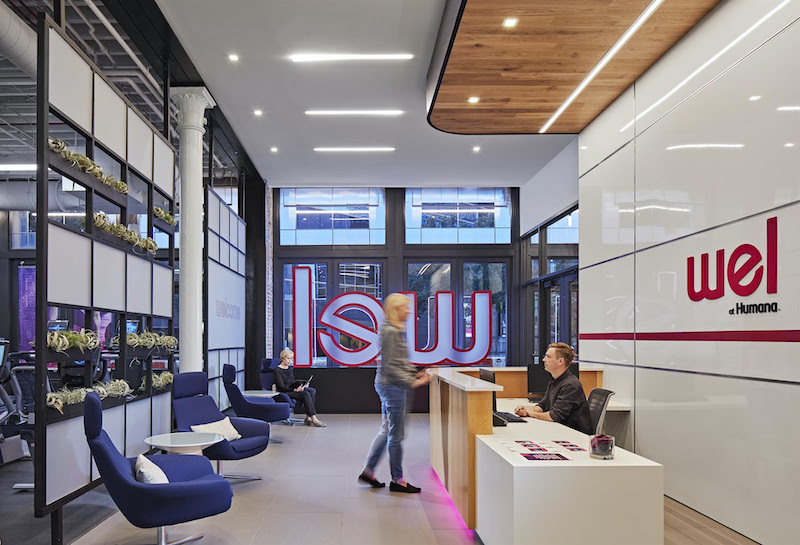Two global design firms focused on interiors are joining forces via a strategic partnership. IA | Interior Architects, which BD+C’s 2019 GIANTS list ranked 11th for architectural revenue, will share resources with Space Matrix, with project experience in over 80 cities, in a Global Studio that connects over 1,400 professionals across 37 locations worldwide.
This partnership will allow the firms—which continue to operate as separate entities—to jointly serve clients in more than 60 countries and over 500 cities. The firms will be completing projects, sharing research, and hosting joint think tanks to expand their expertise and drive innovation.
The two companies had been working on this partnership since last July. “It was important to spend significant time with each other to ensure that our values, culture and business were aligned before formalizing our agreement,” David Bourke, Co-CEO and president at IA, states in an email response to BD+C’s questions. The partnership was scheduled to launch earlier this year, but got postponed by the coronavirus outbreak.
Bourke explains that the partnership, and the global reach it provides both firms, make even more sense because of the pandemic. “This is extremely powerful during a time when international travel, and travel in general, is restricted but projects continue to be designed and delivered for clients. Even in more normal times this will still be true, as there is no substitute for local knowledge and data. Project delivery is complicated, and we believe that by engaging IA Space Matrix, clients will gain a more sustainable and satisfying product.”
 From left: David Bourke, Co-CEO and President, IA | Interior Architects; Arsh Chaudhry, CEO, Space Matrix; Tom Powers, Co-CEO and President, IA | Interior Architects.
From left: David Bourke, Co-CEO and President, IA | Interior Architects; Arsh Chaudhry, CEO, Space Matrix; Tom Powers, Co-CEO and President, IA | Interior Architects.
THE ALLIANCE SPANS THE GLOBE
IA | Interior Architects was founded in 1984, and is employee owned. It claims to be the world’s largest architectural firm focused on interiors. Space Matrix, founded in 2001, has a three-pronged business model that encompasses workplace strategy, interior design, and design-build.
Through the strategic partnership, the firms wanted to create a different delivery model “where we were highly invested in each other” and not just a “loose alliance,” says Bourke. IA has a strong presence in the Americas, Europe, the Middle East, and Africa. Space Matrix has similar strength in Asia Pacific, “so there is no overlap in geography or ambitions” that might impede the goal of offering clients an organized delivery process, says Bourke.
He adds that the firms are aligned in other ways: shared clients, a commitment to design excellence and R&D, and complimentary market portfolios. Both firms have also invested in reimagining design technologies, “which we believe provides enhanced value for our clients creating a competitive advantage,” says Bourke.
Related Stories
| Nov 8, 2013
Exclusive survey: Architects balance ideals, skepticism regarding green strategies
Architects are seeking affirmation that the complex array of programs, systems, and tools at their disposal actually do result in more sustainable buildings, according to a recent survey of architects by Building Design+Construction.
| Nov 7, 2013
Fitness center design: What do higher-ed students want?
Campus fitness centers are taking their place alongside student centers, science centers, and libraries as hallmark components of a student-life experience. Here are some tips for identifying the ideal design features for your next higher-ed fitness center project.
| Nov 6, 2013
Green hotel trends: Industry expands its sustainability focus beyond laundry
There’s more to creating a sustainable hotel than saving water and power by asking guests to reuse their towels.
| Nov 6, 2013
Energy-efficiency measures paying off for commercial building owners, says BOMA study
The commercial real estate industry’s ongoing focus on energy efficiency has resulted in a downward trend in total operating expenses (3.9 percent drop, on average), according to BOMA's Experience Exchange Report.
| Nov 6, 2013
PECI tests New Buildings Institute’s plug load energy use metrics at HQ
Earlier this year, PECI used the NBI metrics to assess plug load energy use at PECI headquarters in downtown Portland, Ore. The study, which informed an energy-saving campaign, resulted in an 18 percent kWh reduction of PECI’s plug load.
| Nov 5, 2013
Net-zero movement gaining traction in U.S. schools market
As more net-zero energy schools come online, school officials are asking: Is NZE a more logical approach for school districts than holistic green buildings?
| Nov 5, 2013
New IECC provision tightens historic building exemption
The International Energy Conservation Code has been revised to eliminate what has been seen as a blanket exemption for historic buildings.
Sponsored | | Nov 5, 2013
Bernards and Colombo leverage Bluebeam Revu to speed up project document management
Bernards, a well-respected, nationally ranked construction firm and Colombo Construction Company, a southern California firm known for its quality healthcare projects, broke ground earlier this year on the $57 Million Tehachapi Valley Healthcare District Replacement Hospital in Tehachapi, California. Read how the team is leveraging Revu to streamline project document management, completing processes in hours instead of weeks.
| Nov 5, 2013
Living Building Challenge clarifies net-zero definitions and standards
The Living Building Challenge has released the Net Zero Energy Building Certification to provide clearer definitions regarding what net zero really means and how it is to be achieved.
| Nov 5, 2013
Oakland University’s Human Health Building first LEED Platinum university building in Michigan [slideshow]
Built on the former site of a parking lot and an untended natural wetland, the 160,260-sf, five-story, terra cotta-clad building features some of the industry’s most innovative, energy-efficient building systems and advanced sustainable design features.

















